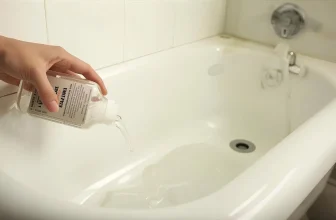How To Tighten Kitchen Faucet Nut Under Sink With Ease?

The leaking faucet in the kitchen can be a real annoyance. They can cause water damage and waste your precious time repairing them. You’ll need to know how to tighten kitchen faucet nut under sink to keep your kitchen faucet running smoothly. With this step-by-step guide, you’ll be able to fix any leaking faucet with ease!
Tools Necessary for Tightening the Faucet Nut
There is no need for a professional plumber to tighten the kitchen faucet mounting nut.
All you need is some basic tools like:
- A pair of pliers
- A flat-head screwdriver
- An adjustable wrench
How To Tighten The Nut Under Your Kitchen Sink?
The steps to tighten faucet under sink may seem intimidating, but once you get the hang of it, it’s a breeze.
Step 1: Shut off the water supply
Start by finding the water shut-off valve under your sink. Turn it clockwise and ensure the water is completely turned off before starting the steps below. This will save you from any unnecessary messes and repairs.
Step 2: Remove the existing handle and escutcheon plate
Remove the existing handle and escutcheon plate that covers your faucet’s nut using a screwdriver. This is typically located on top of the sink’s deck or countertop. Carefully unscrew the handle and escutcheon plate with the screwdriver and set them aside for later use.
Step 3: Check the condition of the nut
Once you’ve exposed your faucet’s nut, look at its condition. Depending on how loose or badly rusted it is, you may need to replace the sink nut entirely. If so, purchase a new one from your local home improvement store and proceed with step 4. Otherwise, move on to the next step.
Step 4: Apply penetrating oil to loosen the nut
To loosen the faucet nut if it’s stuck, spray some penetrating oil directly onto the nut and let it sit for a few minutes. This will help loosen the rust and corrosion that have built up on the threads of your faucet nut.
Step 5: Use the right tool to tighten faucet under sink
Now that you’ve loosened the faucet nut, you can use the tool to tighten kitchen faucet. Typically an adjustable wrench is preferred for this task, but a pair of pliers will also work in a pinch. Use either of these tools to turn the faucet nut clockwise until it’s tight.
Step 6: Replace the handle and escutcheon plate
Now that the faucet nut is tight, replacing the handle and escutcheon plate is time. Use your screwdriver to secure these two pieces back into place on top of the sink deck or countertop.
Step 7: Turn on the water supply
After everything is in its place, turn the water supply back on. Test your faucet to ensure it’s tightened properly, and you’re done! You can now enjoy a leak-free kitchen faucet that is ready for use.
Additional Tips to Keep in Mind
Keeping your faucet nut tight will ensure that your kitchen faucet is leak-free. To make the job easier, here are some additional tips to keep in mind:
The Threads on the nut
Always check the threads of your faucet nut to ensure they are in good condition. If there is any rust or corrosion on them, spray some penetrating oil and let it sit for a few minutes before tightening the nut.
Tighten but don’t over-tighten
When tightening the nut, make sure not to over-tighten it. Over-tightening the nut can damage the threads or cause the faucet nut to break, making your repair job much more difficult.
Regular maintenance
Regularly inspect and maintain your kitchen faucet by checking for leaks or loose nuts. If you catch a leak early on, it will be much easier to fix and prevent any further damage. This will also ensure that your kitchen faucet remains leak-free for years.
When You Need To Call a Plumber?
While tightening a kitchen faucet nut may be a relatively easy job, there are certain situations in which it is better to call a professional plumber.
If your faucet has corroded or rusted nuts that won’t come loose, you should call a plumber. This is because forcing these nuts loose can cause damage to the faucet, and you may have to replace the entire fixture.
If you must replace the faucet entirely, it’s best to call a plumber. They will be able to correctly install the new faucet and ensure no leaks or other issues with the installation.
Also, if you don’t have the right tools for the job or simply don’t feel comfortable doing it yourself, then calling a plumber is the safest option. They will be able to identify any underlying issues with your kitchen faucet that you may not be aware of and provide a more permanent solution.
Frequently Asked Questions
If your faucet feels loose, it can be due to several reasons. The most common is an improperly installed or worn-out faucet stem. Another reason could be that the mounting nuts underneath have come loose and must be tightened.
Tightening up your sink basin faucet is relatively straightforward. First, locate the nuts underneath the faucet, then turn them clockwise with an adjustable wrench to secure the mounting bolts and ensure your faucet is firmly secured.
Sometimes the nuts underneath your faucet are located in an area that is particularly hard to reach. In this case, special tools such as sockets or basin wrenches can be used to get into those tighter spaces.
You should always tighten your faucet supply lines firmly but not too tightly. The connections should be snug but not over-tightened, which can cause damage or leak.
Faucet fittings should be tightened just enough that they won’t leak water but not to the point where it is too tight. You should be able to turn the nut or fit it with your hand, and it shouldn’t require any special tools.
If you over-tighten a faucet, a few potential issues can arise. First, the nut or fittings can be damaged due to the extra tension, resulting in leaking. Additionally, the pipe itself might be damaged due to the excess pressure. It’s best always to ensure that your faucet is tightened enough and not too much.
You can help prevent any potential faucet issues by regularly inspecting your faucets for signs of wear and tear. Check the connections for leaks and ensure all parts are in good condition. Additionally, you should clean your faucets frequently to keep dirt and debris from building up, which could cause corrosion or clogs.
Conclusion
Once you’ve followed the steps above, your kitchen faucet should be tightened and ready. You can turn the water back on, run it through the faucet, and enjoy a secure connection between your sink and faucet! Plus, you won’t have to worry about leaks or other problems that might have cropped up had you left the nut loose.
But don’t forget to keep an eye on your newly tightened faucet in case the nut decides to come loose again. A few drops of thread sealant will help ensure it stays secure longer! And if all else fails, at least you know how to tighten kitchen faucet nut under sink and can do it yourself without calling in a plumber.





